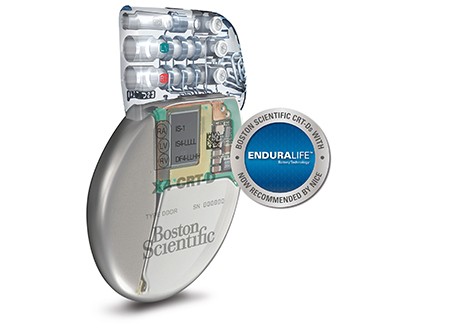Today, the National Institute for Health and Care Excellence (NICE) issued medical technology guidance recommending the use of Boston Scientific Corporation (NYSE: BSX) cardiac resynchronization therapy defibrillators (CRT-D) powered by EnduraLife™ Battery Technology for treating patients with heart failure.
In their evaluation, NICE – which provides evidenced-based guidance to improve health and social care in the National Health Service (NHS) in the United Kingdom – concluded that the extended battery life observed with Boston Scientific EnduraLife -powered CRT-Ds is likely to reduce the number of avoidable replacement procedures a patient may have to undergo, thereby offering improved outcomes for patients and potential savings to the NHS in England of approximately £6 million in the first five years.
The savings were calculated by modeling the costs associated with early replacement procedures, such as a reduction in hospital admissions, bed days and procurement costs. Fewer replacement procedures also equate to a reduction in associated costs accrued from post-operative complications and infections – both of which also have a measurable impact on morbidity and mortality.
“The NICE guidance reinforces the multi-faceted importance of battery longevity in devices treating patients with heart failure and life-threatening ventricular arrhythmias,” said Dr. Jay Wright, consultant cardiologist, Liverpool Heart and Chest Hospital, Liverpool, United Kingdom. “Additionally, the reduction in replacement procedures and potential savings identified within the guidance could offer longer-term relief to NHS providers who have recently seen an increase in the number of patients requiring further in-hospital treatment.”
The NICE medical technologies advisory committee found that the evidence from 16 independent clinical and economic studies supported a case for adoption and concluded that EnduraLife-powered CRT-Ds have a greater battery capacity and longer battery life compared with other CRT-Ds reviewed.
“Battery life should be a key consideration in cardiac device selection for the millions of patients who rely on them daily,” said Kenneth Stein, M.D., senior vice president and chief medical officer, Global Health Policy and Rhythm Management, Boston Scientific. “We are proud to have our EnduraLife Battery Technology recognized by NICE’s evidence-based review process and available for the benefit of patients and the healthcare system at large.”
EnduraLife Battery Technology, which has nearly two times the usable battery capacity as certain competitive devices[i],[ii] and is packaged in a device up to 18 percent smaller than other CRT-Ds[iii],[iv],[v], was introduced in the company’s line of CRT-Ds in 2008.
For more information on the NICE guidance, visit www.nice.org.uk/guidance/mtg33.
Boston Scientific transforms lives through innovative medical solutions that improve the health of patients around the world. As a global medical technology leader for more than 35 years, we advance science for life by providing a broad range of high performance solutions that address unmet patient needs and reduce the cost of healthcare. For more information, visit www.bostonscientific.eu and connect on Twitter and Facebook.
Cautionary Statement Regarding Forward-Looking Statements
This press release contains forward-looking statements within the meaning of Section 27A of the Securities Act of 1933 and Section 21E of the Securities Exchange Act of 1934. Forward-looking statements may be identified by words like “anticipate,” “expect,” “project,” “believe,” “plan,” “estimate,” “intend” and similar words. These forward-looking statements are based on our beliefs, assumptions and estimates using information available to us at the time and are not intended to be guarantees of future events or performance. These forward-looking statements include, among other things, statements regarding our business plans, clinical trials, regulatory approvals and product performance and impact. If our underlying assumptions turn out to be incorrect, or if certain risks or uncertainties materialize, actual results could vary materially from the expectations and projections expressed or implied by our forward-looking statements. These factors, in some cases, have affected and in the future (together with other factors) could affect our ability to implement our business strategy and may cause actual results to differ materially from those contemplated by the statements expressed in this press release. As a result, readers are cautioned not to place undue reliance on any of our forward-looking statements.
Factors that may cause such differences include, among other things: future economic, competitive, reimbursement and regulatory conditions; new product introductions; demographic trends; intellectual property; litigation; financial market conditions; and future business decisions made by us and our competitors. All of these factors are difficult or impossible to predict accurately and many of them are beyond our control. For a further list and description of these and other important risks and uncertainties that may affect our future operations, see Part I, Item 1A – Risk Factors in our most recent Annual Report on Form 10-K filed with the Securities and Exchange Commission, which we may update in Part II, Item 1A – Risk Factors in Quarterly Reports on Form 10-Q we have filed or will file hereafter. We disclaim any intention or obligation to publicly update or revise any forward-looking statements to reflect any change in our expectations or in events, conditions or circumstances on which those expectations may be based, or that may affect the likelihood that actual results will differ from those contained in the forward-looking statements. This cautionary statement is applicable to all forward-looking statements contained in this document.
